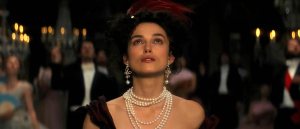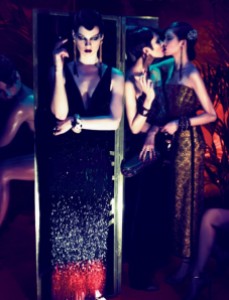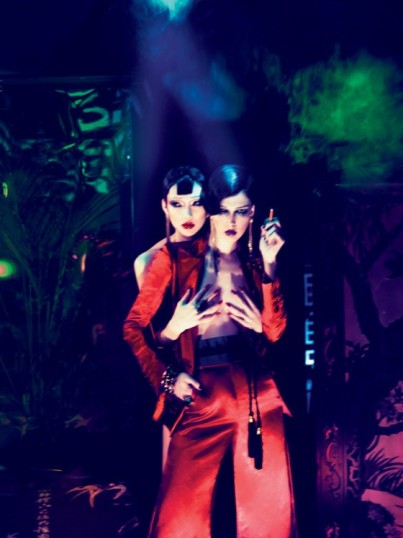Chanel‘s original Coromandel gradually turned into my all-time favourite modern designer scent, so today I thought I’d look at the recent extrait or pure parfum version and how it measures up. Spoiler alert: It’s a good successor to the EDT. That was not my opinion of the replacement 2016 eau de parfum, by the way.
Tag Archives: Coromandel perfume review
Perfume Review: Chanel Coromandel – Frankincense & Opium Dens
Were the Three Wise Men or Magi visiting Bethlehem today, Chanel’s Coromandel is a gift that they might have enjoyed wearing (even if it isn’t a suitable gift for a child in a manger).
So, too, would those “Chasing the Dragon” in Imperial China’s opium dens, their limbs sinuous and contorted by their dark obsessions. It is, without question, a perfume of the mysterious, ancient East.
Coromandel is said to be an homage to Coco Chanel’s beloved lacquered, wooden Chinese folding screens and was introduced to the world in 2007 as part of Chanel’s six-line collection called “Les Exclusifs.” It was created by Chanel’s house perfumer, Jacques Polge, along with an equally famous “nose” in the industry, Christopher Sheldrake. According to Chanel’s own description on their website, “the elaborate scent unfolds in undulating detail, starting with an amber vibrato, followed by dry notes of Frankincense and Benzoin, then, soulful woody notes that add elegance and depth to the sensuous accord’s striking trail.”
The notes, according to a reviewer (“Zut”) on Basenotes, are as follows:
Top: citruses, bitter orange, neroli
Heart: jasmine, rose, patchouli, orris
Base: incense, olibanum [also known as Frankincense], benzoin, woodsy notes, musk, Tahitian vanilla
Coromandel is a perfume that reminds me that life would be much easier if I had significantly less expensive tastes. It’s not a perfume I adore with a searing passion, but it is a perfume that I definitely like a lot. A LOT. (Far too much for my wallet’s good health, actually. I suspect I will try to buy a full bottle of this.)
Coromandel opens with a burst of zesty citrus, powder and vanilla. Unlike one reviewer on Basenotes, I don’t smell bitter orange, only basic citrus. Two to four minutes in, the citrus is gone completely, leaving only vanilla musk, patchouli and a hint of almond. Exactly 10 minutes from the time I put in on, the vanilla musk turns darkly and intensely peppery. It is a sharp and dramatic change in such a brief period of time. As the frankincense and/or patchouli rise to the forefront, the perfume changes again. There are wisps of a milk chocolate smell that start to emerge.
I must be honest, and I need to say this from the onset, I truly cannot tell if it is the patchouli or frankincense that is more at play with Coromandel. Everyone talks about how this is such a patchouli monster, and it most definitely has patchouli at its heart. But I truly think that this is more of a frankincense monster than a patchouli one. While there are all kinds of dirty, dark patchouli out there, they all generally seem to have (on me) a warmer, softer edge than what I am picking up in Coromandel. Coromandel’s patchouli (if that is what I’m smelling for the most part) is different than the dirty patchouli that is in Hermès’ Elixir de Merveilles, to mention a patchouli perfume that I just recently reviewed. On me, Coromandel has a much more smoky, piercing, sharp, almost screeching (but in a good way), burning incense note, one that I associate with frankincense far more than with patchouli.
Regardless of whether it’s the frankincense or the patchouli that truly dominates here, the overall whole in the early stages is that of a very milky oriental. I have definite flashbacks to a milky Chai, with a touch of cinnamon, a good dollop of white cocoa, sugar, amber and lots of powdered vanilla. It’s an inescapable image for the first 40 minutes of the perfume’s development on my arm. It’s also a very comforting scent that brings to mind curling up under a thick, beige cashmere blanket, next to a roaring fire, as you sip that aforementioned Chai tea.
It is around this time that Coromandel’s milky vanilla spice has been joined by rose, violet and a faint hint of jasmine. It’s not the full-blown, blowsy, overly-sweet rose of YSL’s Paris, but a softer rose that is moderated by the violet note. The rose-violet-vanilla scent reminds me strongly of the old-fashioned, expensive lipsticks I used to buy in Paris, and of Chanel’s lipsticks themselves. The cause is the orris root mentioned amongst the ingredients. Orris root is the root of the iris flower ,and is often used in perfume or makeup as a fixative or base. It has a richly floral, heavy scent, often evocative of violets. And I can definitely smell it here.
There is supposed to be a strong thread of amber floating throughout Coromandel, but I find it overwhelmed by the frankincense. It’s amazingly strong, and I’m glad for it. I absolutely adore it, more than the increasingly common amber accord that is found in so many fragrances today.
Strangely enough, the perfume is getting more intense on my arm. Two and a half hours in, I wrote in my notes: “how is this just getting stronger???!?!?!!” It’s quite a feat, but it has put me in Coromandel’s thrall. As the peppery smoke increases along with the incense, I get flickering images of an old, quiet, dark Russian Orthodox church where black-robed, black-bearded priests walk through the hushed aisles, swinging those gleaming silver canisters back and forth as the smoke drifts all around them.
With every passing moment, however, the image which grows strongest in my mind is that of a lush, rich, red-silk lined opium den in Imperial China. (Or Johnny Depp “chasing the dragon” in a London opium den in the film, “From Hell.”) Coromandel is one of the very few things I’ve smelled that strongly calls to mind YSL’s Opium, in its true, vintage, 1970s, un-reformulated parfum glory. That almost sexually decadent smokiness is redolent of dark rooms reeking of vice and sinuous bodies, their limbs twisted and contorted in the pursuit of their madness.
True, unvarnished, untainted Opium is my absolute favorite perfume in the world. (We shall not speak of the travesty that it is in its current incarnation. We cannot. It is simply too painful.) True Opium was an ode to licentious abandon and unbridled passion.
It was pure, oozing sex, writhing under a full moon, baying in passion as your darkest side emerged and you lost all control. Opium captured my soul in the 1970s as a young child and it never let go. For true Opium, I would go to hell and back.
Coromandel is not Opium. It is too powdery, especially in its dry-down. It lacks Opium’s rawness, its power and its dark, unctuous slither. But it tries to be Opium’s soft, refined, sweet, baby sister in some ways. The incense and smoke that almost burns your nose is very evocative of Opium’s dark side. But it is incense and smoke wrapped up in powder, pearls, lace and cashmere, not in red-silk tuxedo held half-open and revealingly with one, long, taloned red-laquered finger nail.
No, that is not Coromandel. In its middle and final stages, Coromandel may be better suited to Tolstoy’s tragic heroine, Anna Karenina, in the novel by the same name. Try to imagine Kiera Knightley’s “Anna Karenina” in an old, dark Russian Orthodox Church and you may get closer to the image that Coromandel evokes when I wear it. 
A few final things: this is not necessarily a perfume that only a woman can wear. I think its smokiness and incense-y character makes it very accessible to men, as do the “woody” notes that so many seem to smell so strongly (but not me). I have read some female  commentators say that it’s actually “too masculine.” I find that simply baffling. This is a scent everyone can wear if they should so choose. In fact, one of my closest male friends is bewitched by it. He is a man who adores YSL’s controversial, roaring, polarising, definitely masculine M7, too, so it’s not as though he leans towards “feminine” scents. If you’re a man and you’re intrigued by Coromandel, I think you should give it a shot.
commentators say that it’s actually “too masculine.” I find that simply baffling. This is a scent everyone can wear if they should so choose. In fact, one of my closest male friends is bewitched by it. He is a man who adores YSL’s controversial, roaring, polarising, definitely masculine M7, too, so it’s not as though he leans towards “feminine” scents. If you’re a man and you’re intrigued by Coromandel, I think you should give it a shot.  Even if you’re someone who normally fears powdery or powdery vanilla scents, the degree of smokiness and spice may be enough to offset any “old lady” concerns that you might have.
Even if you’re someone who normally fears powdery or powdery vanilla scents, the degree of smokiness and spice may be enough to offset any “old lady” concerns that you might have.
If you simply can’t get passed the thought of powdered vanilla, then you may want to try Serge Lutens’ Borneo 1834, also created by Christopher Sheldrake. I’ve never tried it but, from reviews like the one I’ve linked to there, it seems that there are a number of similarities. Both share what appears to be Sheldrake’s signature: a bold, sweet, spicy oriental that almost seems like a gourmand perfume at times but which is built around a solid base of patchouli. Borneo, however, is said to have a greater darkness with more bitter dark chocolate (in lieu of the white cocoa) and much earthier, heavier patchouli. (By the way, there isn’t any chocolate actually in either perfume. They simply evoke the scent on occasion.) If Coromandel is not for you, then perhaps Borneo 1834 will be. I hope you will let me know what you think if you try either one.
______________________________




